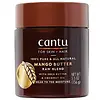What's inside
What's inside
 Key Ingredients
Key Ingredients

No key ingredients
 Benefits
Benefits

 Concerns
Concerns

 Ingredients Side-by-side
Ingredients Side-by-side

Water
Skin ConditioningButyrospermum Parkii Butter
Skin ConditioningCocos Nucifera Oil
MaskingMacadamia Ternifolia Seed Oil
EmollientMangifera Indica Seed Butter
Skin ConditioningPersea Gratissima Oil
Skin ConditioningGlycerin
HumectantAloe Barbadensis Leaf Extract
EmollientHydrolyzed Silk
HumectantMyrtrimonium Bromide
PreservativeMelia Azadirachta Seed Oil
EmollientDaucus Carota Sativa Seed Oil
EmollientSorbitol
HumectantPanthenol
Skin ConditioningCaprylyl Glycol
EmollientOcimum Basilicum Oil
MaskingLonicera Caprifolium Flower Extract
PerfumingLonicera Japonica Flower Extract
Skin ConditioningTocopherol
AntioxidantHibiscus Syriacus Flower Extract
AntioxidantWater, Butyrospermum Parkii Butter, Cocos Nucifera Oil, Macadamia Ternifolia Seed Oil, Mangifera Indica Seed Butter, Persea Gratissima Oil, Glycerin, Aloe Barbadensis Leaf Extract, Hydrolyzed Silk, Myrtrimonium Bromide, Melia Azadirachta Seed Oil, Daucus Carota Sativa Seed Oil, Sorbitol, Panthenol, Caprylyl Glycol, Ocimum Basilicum Oil, Lonicera Caprifolium Flower Extract, Lonicera Japonica Flower Extract, Tocopherol, Hibiscus Syriacus Flower Extract
Ingredients Explained
These ingredients are found in both products.
Ingredients higher up in an ingredient list are typically present in a larger amount.
This ingredient is also known as shea butter. It is an effective skin hydrator and emollient.
Emollients help soothe and soften your skin. It does this by creating a protective film on your skin. This barrier helps trap moisture and keeps your skin hydrated. Emollients may be effective at treating dry or itchy skin.
Shea butter is rich in antioxidants. Antioxidants help fight free-radicals, or molecules that may harm the body. It is also full of fatty acids including stearic acid and linoleic acid. These acids help replenish the skin and keep skin moisturized.
While Shea Butter has an SPF rating of about 3-4, it is not a sunscreen replacement.
Shea butter may not be fungal acne safe. We recommend speaking with a professional if you have any concerns.
Learn more about Butyrospermum Parkii ButterCocos Nucifera Oil is obtained from the kernels of the coconut fruit. In other words, this is coconut oil.
Coconut Oil is rich in fatty acids with lauric acid making up the majority of these. It also contains linoleic acid. Due to this high fatty acid content, coconut oil helps trap moisture and soften skin.
Despite being antibacterial, coconut oil may not be great for acne-prone skin. It is comedogenic and may clog pores. This ingredient may not be safe for malassezia or fungal acne.
Note: Coconut Oil should not replace your sunscreen for UV protection. Studies show it only blocks about 20% of UV.
This oil is non-volatile and has a light scent.
The term 'fragrance' is not regulated in many countries. In many cases, it is up to the brand to define this term. For instance, many brands choose to label themselves as "fragrance-free" because they are not using synthetic fragrances. However, their products may still contain ingredients such as essential oils that are considered a fragrance.
Learn more about Cocos Nucifera OilMangifera Indica Seed Butter isn't fungal acne safe.